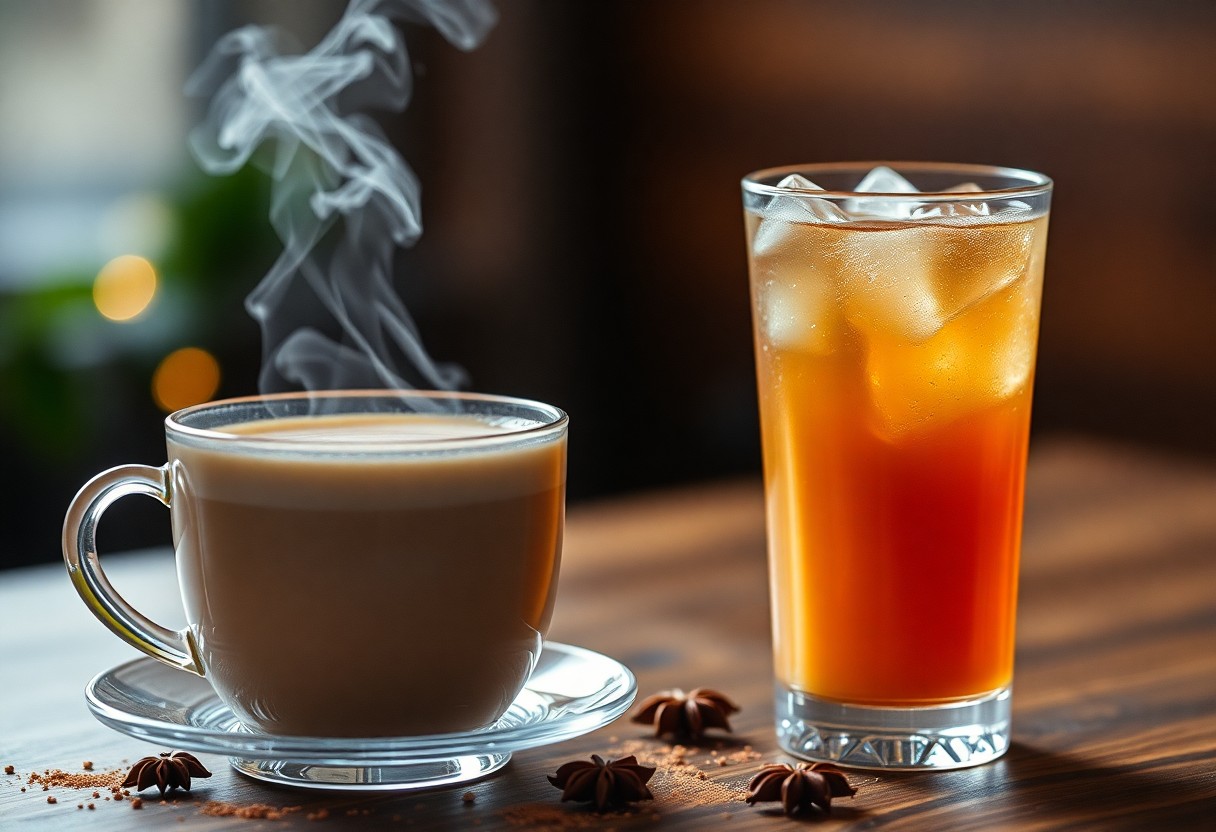There’s a delightful versatility to chai tea that often leaves you pondering the ideal way to enjoy it—hot or cold? This aromatic blend of spiced tea has deep roots in tradition, but contemporary preferences might lead you to explore both options. While hot chai warms your soul and enhances the spices, iced chai offers a refreshing twist, perfect for warmer months. Understanding the nuances of each method can elevate your tea-drinking experience, helping you make an informed choice based on your mood and personal preference.

Key Takeaways:
- Chai tea can be enjoyed both hot and cold, offering versatility depending on personal preference and seasonal enjoyment.
- Hot chai enhances the spices and aromas, making it a warming beverage ideal for colder months or cozy settings.
- Cold chai, often served as iced chai lattes, provides a refreshing option, perfect for hot weather or as a unique summer drink.
History of Chai Tea
To appreciate chai tea fully, you must understand its rich history that spans centuries. Originating in ancient India, chai has evolved from an herbal medicinal brew to the beloved spiced tea known worldwide today. This transition reflects a blend of cultural influences and the changing tastes of societies, ultimately shaping the chai we enjoy now.
Origin of Chai
About 5,000 years ago, chai originated in the Indian subcontinent, where indigenous spices and herbs were initially utilized for medicinal purposes. Over time, tea leaves from China were incorporated into this exotic blend, creating the warm, flavorful beverage known today. Chai quickly became a staple in Indian households, embraced for both its taste and health benefits.
Cultural Significance
Between social gatherings and everyday rituals, chai plays a vital role in Indian culture, symbolizing hospitality and community. It serves as a bridge for conversations and connection, whether shared among friends or offered to guests. Chai’s presence extends beyond India, serving as a reminder of cultural ties and the joy of sharing one’s traditions.
In fact, chai tea’s cultural significance is evident in its ubiquity across various gatherings and celebrations. You may find that in many households, serving chai to guests is a long-standing tradition that conveys warmth and welcomes relationships. Additionally, chai’s rich flavors and ingredients often represent your heritage, providing a profound sense of identity and belonging. With every sip, you are not just enjoying a drink; you are partaking in a tradition that fosters connection and community. This beverage is more than just tea; it is infused with the essence of shared experiences and memories, making it a cherished staple in countless lives.

Traditional Preparation Methods
One of the fascinating aspects of chai tea is its rich tradition in preparation methods, varying widely across cultures and households. Authentic chai often involves a blend of black tea, spices, milk, and sugar, each ingredient playing a pivotal role in crafting its distinctive flavors. Whether you prefer hot or cold, understanding the traditional methods can enhance your appreciation and enjoyment of this beloved beverage.
Hot Chai Preparation
Below is a simple yet aromatic method to prepare hot chai. Start by boiling water with a mix of spices like ginger, cardamom, and cloves. Add black tea leaves and let it steep for a few minutes. Then, incorporate warm milk and sweetener to taste, stirring until the flavors meld together perfectly. Strain into your favorite cup and indulge in the comforting warmth of hot chai.
Cold Chai Preparation
One enticing way to enjoy chai is by preparing it cold. Begin by brewing hot chai using your preferred recipe, then allow it to cool. Pour the cooled tea over ice, adding milk and optional sweeteners for a refreshing twist on a classic. Garnish with spices or mint for an extra touch.
Also, you can enhance your cold chai experience by experimenting with various flavor infusions. Adding ingredients like vanilla, cinnamon sticks, or even a touch of honey can create a unique and refreshing drink. Chilling your chai properly is imperative to achieve that invigorating coolness. Just ensure the tea cools completely before pouring over ice to avoid dilution. Enjoy your cold chai with friends on a warm day or as a delightful afternoon treat!
Flavor Profiles of Hot vs. Cold Chai
All chai enthusiasts will tell you that the flavor profiles of hot and cold chai differ significantly, each offering a unique experience. Hot chai exhibits a comforting warmth, enhancing the bold spices and rich notes of black tea. In contrast, cold chai, often blended with milk and ice, provides a refreshing taste that highlights the sweetness and muted spiciness of the blend, making it an ideal choice for warm weather.
Aroma and Taste Differences
To fully appreciate the differences, it’s necessary to recognize that the aroma of hot chai is robust and inviting, infusing your space with its fragrant spices like cardamom and ginger. On the other hand, cold chai often has a lighter, more subdued aroma, allowing the creaminess of the milk to take the forefront, which translates to a different palette of taste perceptions.
Ingredients Alteration
Between hot and cold chai, the ingredients can be adjusted to enhance each beverage’s unique qualities. You may find that when making hot chai, you tend to use traditional spices like cinnamon, cloves, and a higher concentration of tea to complement the heat. Conversely, for cold chai, you might experiment with lighter ingredients such as sweeteners or flavored syrups to balance the chilled texture.
Consequently, this adjustment in ingredients can greatly impact your chai experience. When preparing hot chai, you’ll benefit from the strong infusion of flavors, delivering a deeply aromatic drink that stimulates your senses. In contrast, cold chai can present a refreshing twist, especially if you incorporate seasonal ingredients like fresh mint or fruit extracts. These small adjustments in preparation can yield a positive drinking experience tailored to your preferred temperature, making it necessary to experiment with various combinations to find your ideal blend.

Health Benefits of Chai Tea
Keep in mind that chai tea is not only a delightful beverage but also packed with various health benefits. The combination of spices like ginger, cinnamon, and cardamom can promote overall well-being, aiding digestion, boosting immunity, and providing anti-inflammatory properties. Additionally, the black tea base contributes crucial antioxidants that can help reduce oxidative stress. By incorporating chai tea into your routine, you can enhance your health while savoring its comforting flavors.
Benefits of Hot Chai
By enjoying hot chai, you can experience a range of benefits such as improved digestion and enhanced blood circulation. The warmth of the beverage can help soothe your stomach, making it particularly beneficial after meals. Furthermore, the spices used in hot chai, like ginger and cinnamon, can provide relief from cold symptoms and boost your metabolism, offering a comforting way to stay healthy, especially during colder months.
Benefits of Cold Chai
After trying cold chai, you may discover it can be refreshing and hydrating while still providing numerous health benefits. Iced chai can help cool down your body during hot weather, making it an enjoyable choice for summer days. Additionally, the same beneficial spices offer antioxidants and anti-inflammatory properties, which can enhance your overall wellness. The chilled version is also an excellent alternative for those who prefer a lighter beverage without sacrificing flavor or health.
In addition to being refreshing, cold chai allows for versatility in your beverage experience. You can easily mix in various ingredients, such as milk alternatives or sweeteners, tailoring it to your personal taste. The key spices remain packed with health benefits that promote digestion and boost immunity. By opting for iced chai, you’re not only treating yourself to a delicious drink but also reaping the positive effects of its nutrient-rich ingredients, making it a smart addition to your wellness routine.
Popular Variations of Chai
For chai enthusiasts, the beverage offers an exciting canvas for creativity with various regional and personal adaptations. From rich, spiced blends to refreshing iced variations, the world of chai is ever-expanding. You can explore traditional recipes, international takes, and even modern twists to cater to your unique taste preferences. Whether you’re in the mood for something warm and comforting or a cool, revitalizing drink, there is a chai variant that’s perfect for you.
Hot Chai Variants
Before stepping into hot chai variants, you should know that these comforting beverages often feature a blend of black tea, milk, and a symphony of spices like ginger, cardamom, and cloves. Classic preparations may include Masala Chai, which is steeped with various spices, or South Indian versions like filter coffee-infused chai. You can also personalize your hot chai by experimenting with the ratio of spices and sweetness to create your ideal cup.
Cold Chai Variants
Chai can also be enjoyed cold, and these refreshing variants are perfect for warm weather.
In fact, cold chai drinks, such as iced chai lattes or chai smoothies, offer a delightful twist on traditional flavors. You can easily make these by chilling brewed chai, blending it with your choice of milk, and adding ice. Consider incorporating vanilla, cinnamon, or even a hint of chocolate to elevate your drink. Cold chai allows you to savor all the spices while enjoying a refreshing beverage; perfect for hot days or a revitalizing afternoon treat!
Serving Suggestions
Many factors can influence how you serve your chai tea, including personal preference and the occasion. Whether you choose to serve it hot or cold, the way you present your chai can enhance the overall experience. Consider pairing your beverage with complementary snacks or adding unique garnishes to elevate your serve. Be it a cozy gathering or a refreshing summer outing, your serving choices can create an inviting atmosphere and make your chai the star of the show.
Best Practices for Serving Hot
One of the best ways to serve hot chai tea is to use a pre-heated cup to maintain its warmth. Pour your chai, and if desired, add your choice of sweeteners or milk at this stage for a well-integrated flavor. To enhance the experience, you can sprinkle a bit of cinnamon or garnish with fresh mint leaves, providing an aromatic and appealing presentation. Always serve immediately to enjoy the full flavors and warmth.
Best Practices for Serving Cold
After brewing your chai, allow it to cool before pouring it over ice to prevent dilution. Strive for a combination of full-bodied spices and sweetness, which will shine when served cold. Adding a splash of milk or a dairy alternative can create a creamy texture. To elevate the drink, consider adding toppings such as whipped cream, a dash of nutmeg, or fresh fruit slices for a refreshing touch on a hot day.
Hence, serving cold chai tea can be an enjoyable and refreshing experience that captures your guests’ attention. To ensure a delightful taste, use freshly brewed, chilled chai rather than store-bought, stale options. Additionally, experimenting with flavored syrups or citrus fruits can add an exciting twist to the beverage. Keep in mind to serve with quality ice to maintain the drink’s integrity without losing flavor, providing your guests with a phenomenal experience they won’t forget.
Final Words
With this in mind, whether you choose to serve your chai tea hot or cold largely depends on your personal preference and the occasion. Hot chai offers a cozy, comforting experience, especially during colder months, while iced chai can be refreshing and invigorating in warmer weather. Experimenting with both temperatures can help you discover how different flavors and spices are enhanced. Ultimately, the best chai is the one that brings you joy, so feel free to embrace both hot and cold versions in your repertoire.
FAQ
Q: What is Chai Tea?
A: Chai tea is a spiced tea that originates from India and traditionally consists of black tea brewed with a blend of aromatic spices such as cardamom, ginger, cinnamon, cloves, and black pepper. It can be served with milk and sweeteners, making it a rich and flavorful beverage.
Q: Is Chai Tea better served hot or cold?
A: The choice between hot or cold chai tea depends on personal preference and the occasion. Many people enjoy chai tea hot, especially in colder weather, as the warmth enhances the spices and makes for a comforting drink. However, iced chai tea can be refreshing in warm weather, allowing for a different experience of the flavors. Ultimately, both options have their merits.
Q: How can I serve Chai Tea cold?
A: To serve chai tea cold, brew the tea with the spices, then allow it to cool. After cooling, you can add milk, sweeteners, and ice to create a refreshing iced chai. For an extra twist, blending the tea with ice creates a chai tea smoothie. You can also experiment with flavored syrups or alternative milks for a unique taste.
Q: Can I use the same chai tea blend for both hot and cold preparations?
A: Yes, the same chai tea blend can be used for both hot and cold preparations. The key is to brew the tea strongly regardless of the serving temperature, as the flavors can mellow when served cold. Adjusting the sweetness and milk content can also enhance the cold version to ensure it remains flavorful.
Q: Are there any health benefits associated with drinking Chai Tea hot or cold?
A: Chai tea offers several health benefits regardless of how it is served. The spices used in chai, such as ginger and cinnamon, have anti-inflammatory properties, can aid digestion, and may help boost the immune system. Enjoying chai tea, whether hot or cold, can also provide hydration and energizing caffeine from the black tea, along with antioxidant properties.
